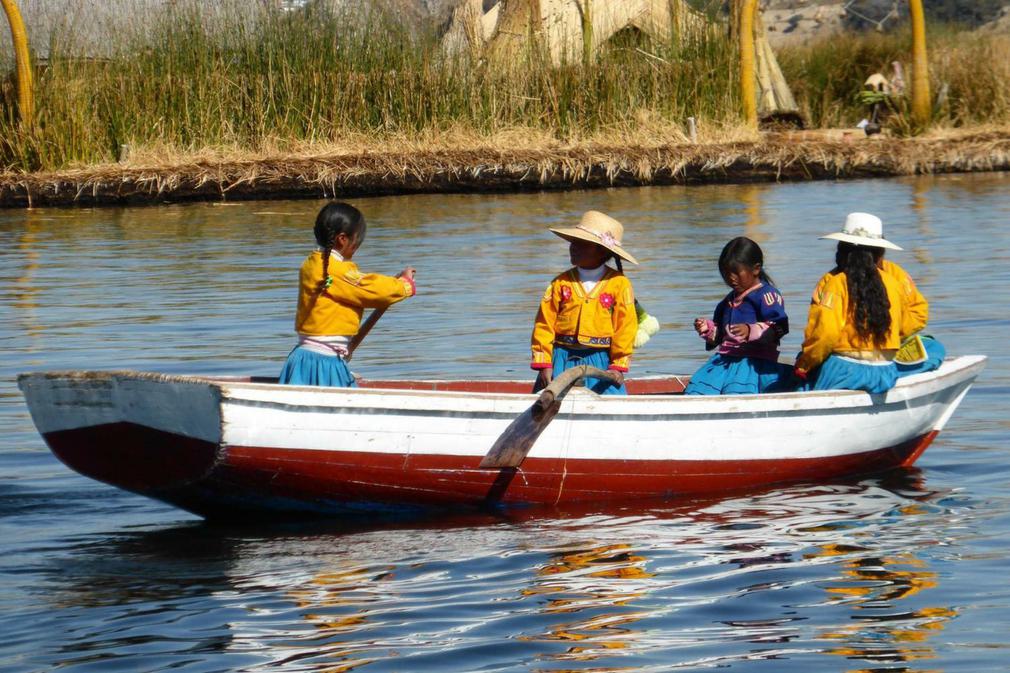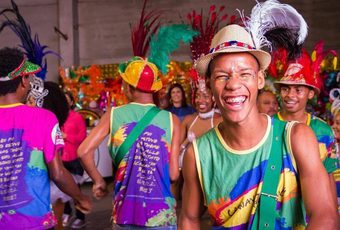What to do around Lake Titicaca

There is plenty to do in and around Lake Titicaca. On the shores of the lake near the town of Puno are the floating reed islands and the rather more permanent weavers' islands. The chaotic city of Juliaca also lies on the lake shore though you are unlikely to do much here except go to the airport.
Activities on Lake Titicaca
Uros Reed Islands
The floating reed islands are a 'must see', situated on the reed beds within Puno bay itself. Basically fresh reeds are harvested then laid on top of anchored but floating platforms of rotting reeds. It is a never-ending process of resurfacing with the bottommost layers deep in the lake eventually rotting away to nothing.
The communities actually only moved out here in the 1950s so this is not any form of ancient way of life but a convenience for some fishing communities. Each island consists of around half a dozen reed houses set on a platform about 50m in diameter.
Underfoot the islands feel like you are walking over a bed of reeds, they are soft and spongy and you can feel the island move gently on the water. Your feet don't get wet but it feels as if they are about to.
Not all of the communities allow visitors so you will be taken to one of a handful of sites. The islands are a big tourist attraction so it feels fairly 'packaged' out here. Having said that, we are careful only to visit islands which are actually permanently inhabited. There are rather less scrupulous people who come across each morning from Puno in their boats, change into traditional dress and sit out to welcome the tourists.
You can tell the difference if you take a sneaky peek inside the houses. Those that are inhabited show all the signs one would expect of the clutter of day to day life. Many of the islands now have solar panels to fire up their lights and the occasional telly.
Taquile Island
Taquile Island is out in the main lake, beyond the reed islands. It is known as the weavers island.
The island is divided into four communities, we visit the quieter of these. There is no electricity or running water on the island yet though there is some solar power. Children walk to school in the main village, which involves a one to two hour walk each way.
The men knit, women weave. Women really only talk in whispers. It is very traditional. You are likely to see a display of weaving, traditional harvesting and a formal dance.
Suasi Island you will only visit if you are staying here. It is on the far side of the lake from Puno, very close to the lakeshore. The only thing on the island is the lodge with beautiful gardens tumbling down the hillside to the waterfront. The waters are wonderfully clear, and quite cold. There is a guide at the lodge permanently who is available to lead excursions (included in the price).
Please note that the atmosphere is very relaxed here so you may well need to go off to find them and tell them what you want to do and when. There is a 'menu' of excursions at reception.
For instance, you can paddle one of their kayaks around the island or be taken around on the lodge zodiac. If you do kayak around the island please go with the lodge guide and seek advice before setting off. It is often windy in the afternoon and the waters can become treacherous. On a calm morning it takes about an hour to paddle round the whole island watching out for birds and vicuna along the way.
There are also walks here on the island and across on the mainland.
At night you can go star gazing as there is no light pollution at all. There is limited electricity here so there is not much to do other than relax, enjoy the silence and relax some more. Having said that there is now wireless internet and, strangely, mobile phone coverage on the island.
The Andean Sauna is a treat. You need to advise them about four hours ahead of time if you want a sauna. You then go into this rather cool, damp stone room and they release the hot water into a pool which is jammed full of eucalyptus branches. As the hot water hits the leaves, a lovely smell rises up. When I went to look for the controls to the sauna (the water was a little cool) my search didn't reveal any likely looking buttons or dials. Then I saw a door leading outside to more or less the back of the sauna. There, sitting outside, was a member of staff fanning a bonfire to heat the water for the sauna. It is that high tech!
You can also have a massage on Suasi island for around US$30 per half hour. Once you are fully relaxed, you can face the drive back around the lake to Juliaca.
This is a four-hour drive of which three hours are on rough and very rough dirt roads. Don't take on too much liquid the morning of your departure and go to the loo just before you leave, there is nothing by way of facilities along the way. Depending on group size you will either be in a 4x4 or in a beefed up mini-bus but there is no way of ignoring the state of the road.
Please bear in mind that the first section is very bumpy but then it gets incredibly bumpy so don't be lulled into a false sense of security. On the plus side, you pass through some very remote agricultural communities so there is lots to see.
What to do in Puno
Puno is a city of around 160,000 inhabitants set around a sweeping bay of Lake Titicaca with mountains behind. The bay looks big, it is big, but it is a mere pocket of the main lake as you will see if you are crossing over to Suasi Island or visiting Taquile.
Most people stay in Puno just for one or two nights. If you are on your way to Suasi Island then it will be a one night stay, if you are doing a day trip onto the lake then you may have two nights in Puno. There is little of much interest here truth be told, the setting is lovely but the town itself a tad grim.
In its defence, they have pedestrianised the main street running up from the central square and this has lots of restaurants and bars and small shops. It is actually a very pleasant place for a stroll and to feel like you are in a bit of authentic Peru.
As civilised and safe as Cusco is, it is nice to be in a town such as Puno where you feel like you are fitting in around the locals and not the other way round. You should take care when in Puno, stay in the pedestrianised central area unless you are accompanied by someone trustworthy.
What to do in Juliaca
Leave.
This may sound harsh but it's the truth, the only reason to be in Juliaca really is to fly on somewhere else. You will cross through Juliaca if you are coming on the train from Cusco to Puno or vice versa. You will also pass through on your way back overland from Suasi Island.
However, there really is nowhere you are going to want to stay in this chaotic city of around 250,000 people. What you do want to do in Juliaca is just look, it is absolutely fascinating. Tricycle rickshaws race cars and buses and lorries down bumpy roads which are punctuated by piles of dirt made into chicanes.
Note the lack of roofs in the city, almost every building has metal reinforcing rods sticking out of the top. This is because you pay only land tax, not the higher property tax, if your house is still under construction. For this reason about 95% of houses in both Juliaca and Puno are ostensibly 'under construction', and have been for generations. The city is a massive funnel of goods into Peru from Bolivia and beyond into Argentina, Brazil, etc. It is a crossroads in the most literal sense.
Look out for the market which runs along the railway tracks and see if there is anything you can't see. My favourites were some barber chairs completely out in the open about two metres from the train tracks operating a full barber service. Pool tables, again completely out in the open on the side of the railway lines with people playing pool as you might see in your local pub.
Great fun, fascinating to watch but really not a place to consider exploring on foot!
Our Peru holidays Get in touch Subscribe to The Pothole
The Pothole is Pura Aventura's popular monthly email. We share what we love, what interests us and what we find challenging. And we don't Photoshop out the bits everyone else does. We like to think our considered opinions provide food for thought, and will sometimes put a smile on your face. They've even been known to make people cry. You can click here to subscribe and, naturally, unsubscribe at any time.
The Pothole is Pura Aventura's popular monthly email. We share what we love, what interests us and what we find challenging. And we don't Photoshop out the bits everyone else does. We like to think our considered opinions provide food for thought, and will sometimes put a smile on your face. They've even been known to make people cry. You can click here to subscribe and, naturally, unsubscribe at any time.






